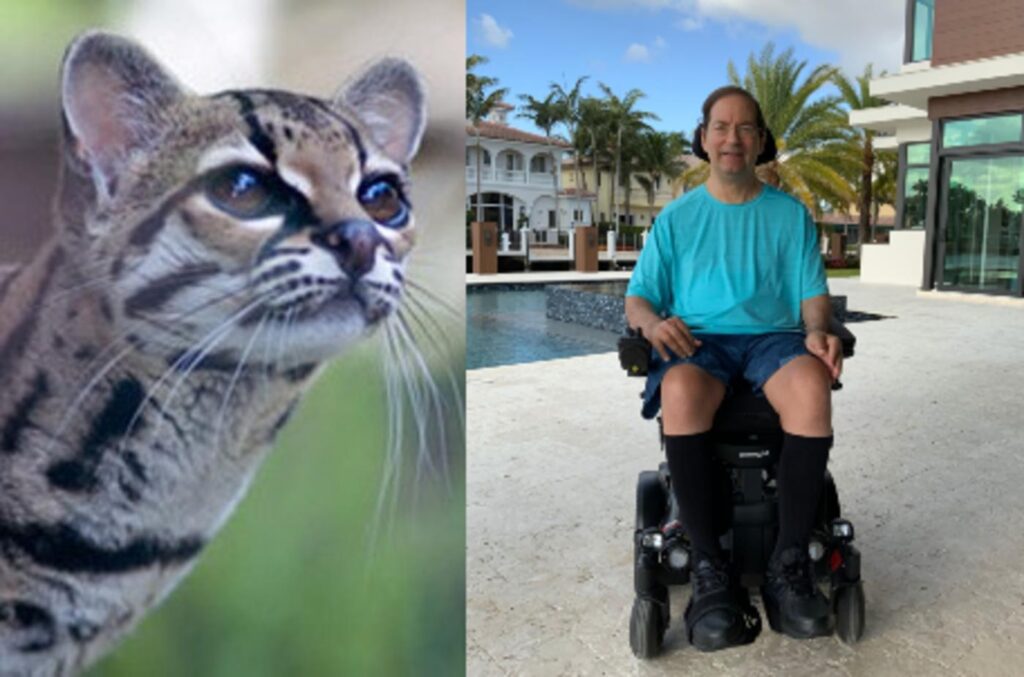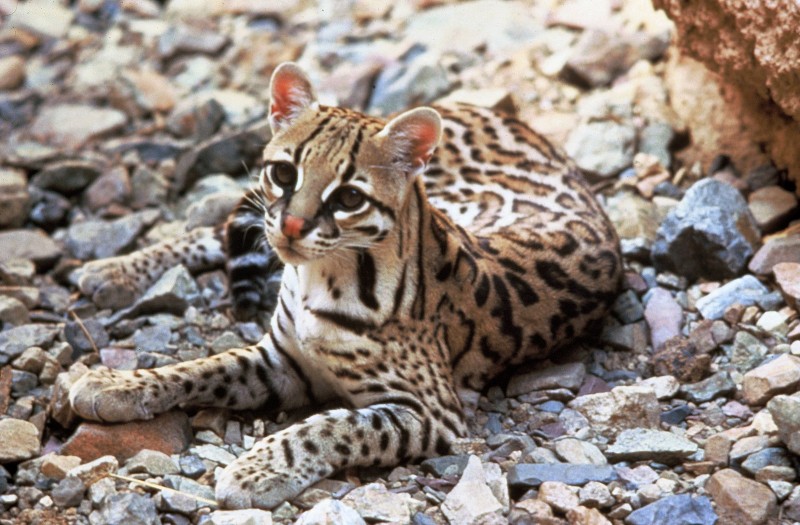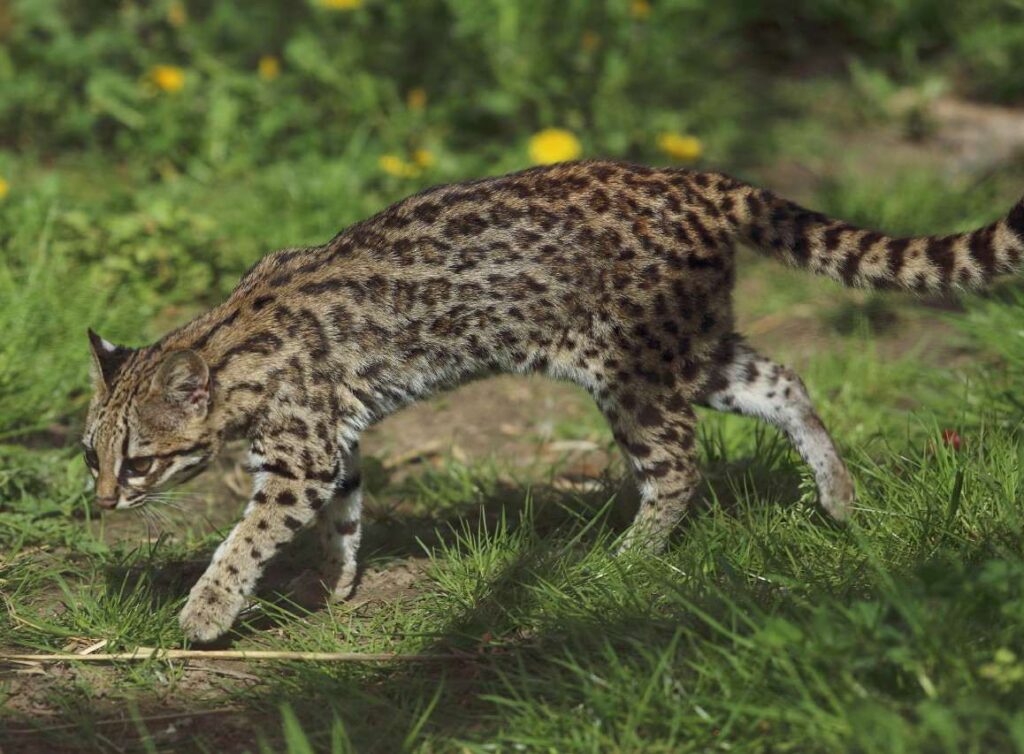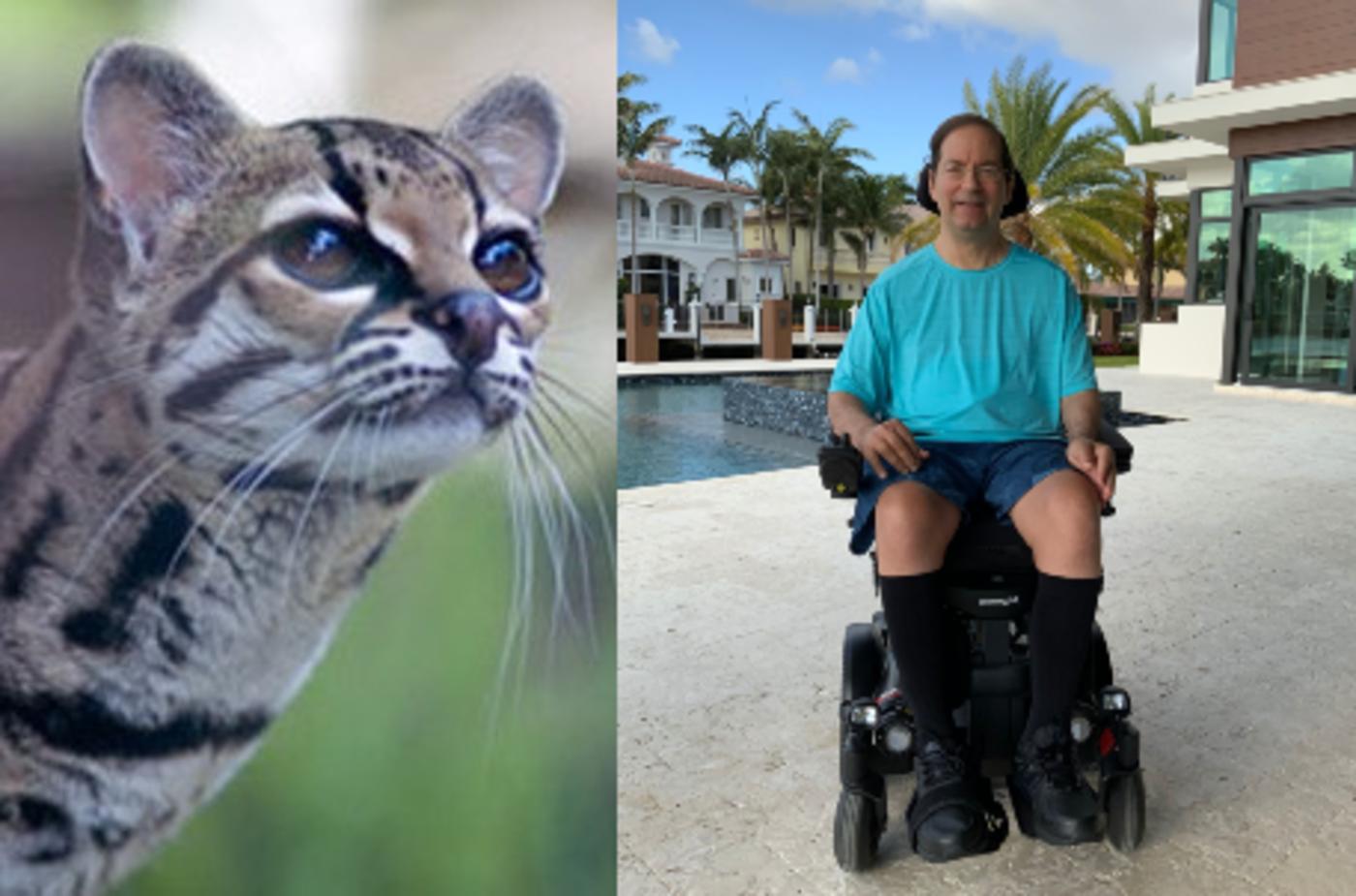As a quadriplegic, Jon Ayers can’t move his limbs, but his voice is filled with excitement. His eyes dart around his office, projecting the illusion of a rainforest that’s filling his imagination with such enthusiasm that soon trees and vines begin to appear in the corners of my office as well.

Jon is describing to me a margay, a tree-dwelling species of wild cat from Central and South America, and the only species that can climb down a tree head first—a trait which endears the 4 kilogram cat to him above all others.
The margay is just one of more than 30 different small wild cat species, many of which are little known—going unseen under a big shadow cast by the big cats like lions and tigers.
But Jon is not willing to sit by and watch these charismatic animals go extinct, so is investing a $20 million personal fortune in an effort to reverse declining trends in small wild cat populations around the world.
Ayers is a panthera person, a felid person, as well as the former-CEO of one of the world’s most successful veterinary diagnostics companies: IDEXX Laboratories. For 17 years he captained the company which appreciably advanced the standard of care for veterinary medicine.
Under his leadership, from 2002 to 2017, IDEXX’s annual revenues went from $380 million to $2.4 billion, while its share price enjoyed a more than 40-fold increase. Jim Cramer from NBC’s Mad Money called IDEXX “one of the hottest stocks on the market,” in an in-studio interview with Jon on May 2019.
Shortly after that appearance, a cycling accident tragically terminated the use of his limbs, with only his helmet keeping him from passing away. Stepping down from the leadership of IDEXX to focus on his health and recovery, he is now speaking to the public again for the first time since the accident, and is eager to share the details of his new adventure—a leadership and funding position at one of the most effective conservation organizations in the world: Panthera.
“What’s the plan?”

“When you go through a catastrophic accident, you’re dealing with a number of challenges,” Jon Ayers explains to GNN. Jon, who had taken up a proximal role in wild cat conservation with several foundations—one of which he started with his wife Helaine in 2018—sees it as a kind of mental therapy.
Their organization, The Ayers Wild Cat Conservation Trust, works alongside Panthera, a conservation group with a focus on getting the job done, rather than creating the most-detailed body of scientific research. Panthera’s work with jaguars, preserving their migration corridors from Argentina to New Mexico, or the Furs for Life and Arabian Leopard Initiatives for the other big spotted cat, have produced conservation successes that are as good as anything being done today.
“It’s not easy going through something like this and most people don’t do very well,” says Jon. “Not that I’m perfect, but being able to work on something like this is the greatest gift to me… because it helps me through a transition in my life, and because it gives me purpose.”
“I mean I lost so much. There are a lot of things I can’t do anymore, really basic things like brushing my teeth and clipping my fingernails…”
“The thing about spinal cord injuries is that no two are the same. My recovery has been much more slow, although I’ve worked hard at my recovery, and I’ve made a lot of progress, but then you ask yourself, ‘well what’s my purpose?’ And I realized my purpose is to support wild cat conservation.”
His trust contributed a few thousand here or there to Panthera, as they were one of the only conservation missions that really had an awareness of what was needed to begin creating a brighter future for some 33 species of small wild cat that altogether receive around 1% of total cat conservation efforts. Along with his massive cash contribution, Jon also took up a board position.
“It was something I was starting to do, it was something that I have, very fortunately, the financial resources for, but I also have the mental ability and I just think God spoke to me and said: ‘this is the plan.'”
INTERESTING: How One Interior Designer Is Helping The Homeless With Her One Percent Project
In Jon, Panthera’s founder and wild cat-brainiac Dr. Thomas Kaplan feels he’s found “someone who wakes up in the morning and says ‘what can I do to turn the screw of history just a little bit?’”
“Jon’s out of central casting,” Kaplan told GNN. “I’ve really been waiting for someone with Jon’s talents and his passion and his dedication to come into the story.”
There but for the shadows unseen

As I sat down with Jon and Dr. Kaplan on Zoom, the latter had already made his background a photograph of cheetahs lounging on the African Savanah, blending his fiery-orange hair with the grass in the picture, and lending a Bob Ross-like glow to his character.
“The advent of Jon coming into the picture… is really a game changer for small cat conservation,” said Kaplan. “I think it’s probably fair to say that nobody is doing and nobody will have done more to save the 33 species of small cats than Jon and his family.”
“We’re prioritizing the cat species and we’re doing that according to a certain matrix, in order to enable ourselves to know where to begin first. We’re obviously going to give priority to those where the ecology is least well-known,” he explains. “[What is] the rarity? Do they overlap with other small cats or big cats within their landscapes so that we can leverage and harness existing programing and scientific know-how. How vulnerable are they to extinction, how pervasive are the threats?”
He details that the overall mission is “a very ambitious one.” They hope that by 2025, they’ll have more or less filled-in the ecology and devised protection plans for 50% of all the small cat species. By 2030, Panthera wants to be at 100%, but the initial injection of Jon’s capital will be put to work right away prioritizing 11 cat species across Asia, the Americas, and Africa. Especially Asia, where islands like Borneo and Sumatra can contain four or five small cat species, like the Sunda clouded leopard, Borneo bay cat, the flat-headed cat, which goes fishing, and the marbled cat.
“Our aim is that when we commence a program, we want to be able to have observable, measurable impact within five years in being able to save that landscape for those cats,” says Kaplan. “The U.S. government basically said, ‘if Panthera cant save the big cats then nobody can.’ It’s what we’re known for.”
In the course of our discussions, Kaplan eagerly seasons the ambitious rhetoric with the names of cats it’s likely you’ve literally never heard of before, and for some of which, the only entry in the scientific record is a confirmation that, yes, they indeed, exist.
“Across the Americas we’re working on a variety of species ranging from the first wild cat I ever saw: the bobcat, but also extending further south to ocelots, margays, jaguarondis, oncilla, Geoffroy’s cat.”
“At the end of the day, we’re not academic in the sense that we’re doing this in order to prove a point; for us it’s all about applied science. What Jon is enabling us to do is really to fight the battle across the entire arc of the small cat trajectory and be able to do everything simultaneously.”
A match made in heaven
“I think what’s unique [and what] really attracted me to Panthera, they had a focus dedicated to species conservation. So it was cats and nothing else, and I’m a cat person. I’ve always loved cats,” says Jon.
“Panthera had a focus, [and] wanted to grow. Now I don’t know that much about conservation but I’m willing to learn and I’ve learned a lot. But I know how to grow things, and so it seemed like those skills could be applied to a different type of organization.”
Jon is confident he can contribute more than just money to the efforts of saving small cat species around the globe. He has nearly 20 years of business acumen, during which almost every action he took sent the value of the services, the veterinary field, and the stake of the shareholders, up.
“We’re actually supporting people who are doing work with other small cats through the Small Cat Action Program.
“Our goal here is to grow Panthera’s impact on the ecosystems around the world that support cats, and so that takes certain leadership, it takes seeing around corners, it takes some disciplines that maybe aren’t traditionally a strong part of conservation organizations, things like financial management.”
Large cats are often protected—tigers for example—by utilizing apex predator or umbrella species conservation strategies.
“Even small cats can be on top of the food chain. You can’t just conserve the cat without conserving the ‘catscape’ which means of course, the entire ecosystem has to be supported. So through cats we’re having a much broader impact on the conservation of nature,” says Jon.
What’s your favorite small wild cat?
“It’s kind of like asking me what’s my favorite child!” Jon answered me, eliciting laughter from all the three of us. He would answer that it was the tree-loving margay.
MORE: #WallStreetBets Traders Donate $300,000 to Adopt Gorillas From Dian Fossey Fund
“They’re like monkeys. They can climb up trees, they can climb vines upside-down, and they can climb down trees headfirst. How can they climb down trees head first? Because they’ve evolved over time to rotate their paws to go in the opposite direction.”
“As an entrepreneur I have a special affinity for the black-footed cat,” explains Kaplan. “It’s Africa’s smallest wild cat, but if you think of it as a fighter pilot, it has a 60% success rate when it goes out hunting.”
Amongst all the stuff one hears about biodiversity these days, small cats just don’t get much attention. But if philanthropists in the future start donating to small cat conservation, it will be a direct consequence of the union that’s just been made at Panthera—a match made in heaven it seems—as Jon, who nearly lost all of his nine lives, reflects on his horrific injury and reminds me “God always has a plan.”
HELP Your Friends Get a Feline For the Good News—Share This Story With Them…




















